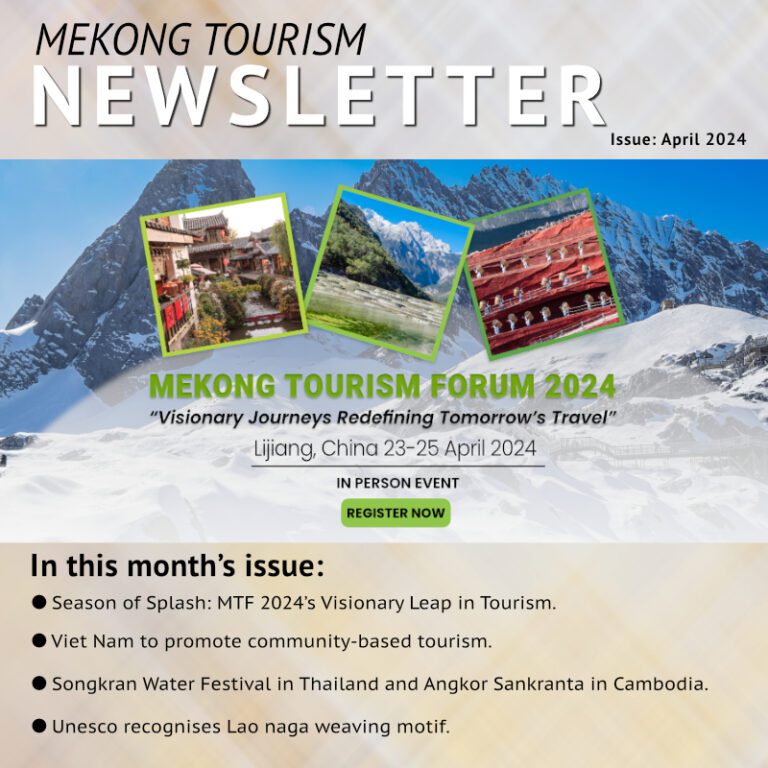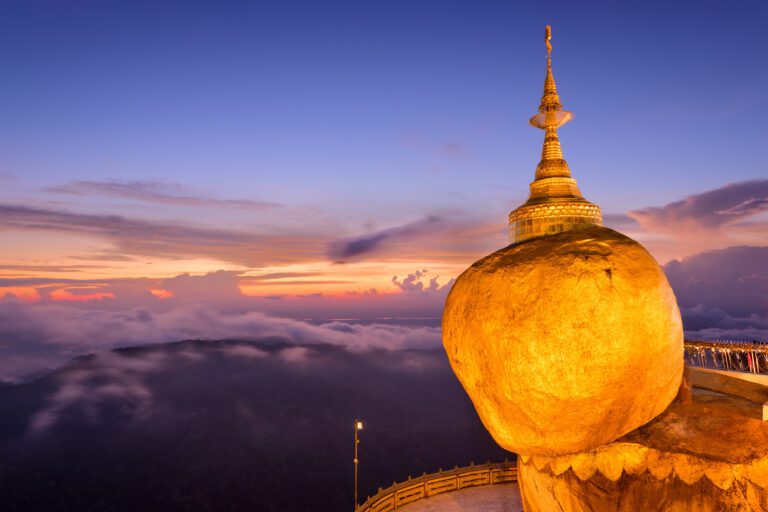
Protecting and preserving intangible cultural heritage (ICH) is increasingly gaining momentum as the world sees this aspect of culture and heritage disappearing at a fast pace. ICH refers to intangible aspects of culture and heritage like ideas, music, language, food, knowledge etc. And as global challenges like climate change gather momentum, there is an increasingly urgent need to take charge of the protection of the intangible side of cultural heritage.
Sustainable tourism development supporting the preservation of intangible cultural heritage (ICH) is increasingly something tourism planners should consider, including tourism planners in the Mekong region. The preservation of ICH potentially also makes tourism development more sustainable. Challenges like climate change are creating situations where places undergo changes; rivers and lakes are drying, forested areas are declining, flora and fauna are edging closer to extinction, and people move (relocate).
Tourism activities utilise much cultural and heritage assets and that potentially should result in the motivation to act to preserve such resources. There is undoubtedly a strong link between tourist activities and loss of ICH.
What is ICH? Why is it important in tourism?
Intangible Cultural Heritage (ICH) is an evolving discipline that’s increasingly being incorporated into the study of tourism. ICH has been identified by UNESCO as the “practices, representations, expressions, knowledge, skills – as well as artefacts and cultural spaces associated therewith – that communities recognise as part of their cultural heritage” (Bonn, Kendall and McDonough, 2017, p8). In essence, ICH refers to the ephemeral expressions of a community’s identity, sometimes in relation to its tangible aspects such as cultural instruments and objects. Five domains have been highlighted by UNESCO – “languages, performing arts, social practices (such as rituals and festive events), knowledge and practices concerning nature and traditional craftsmanship” (ibid, p9).
ICH can be said to have created a new dimension for the study of tourism. When ICH is positioned as part of a community’s tourism efforts, economic benefits and higher employment rates can be notably observed. In addition, the software of the community may be enhanced through stronger identities and pride of the cultural custodians (Su, 2018). Essentially, community ownership over these intangible practices is heightened and along with it, the values of these ICH are defined (ibid). These enhancements, coupled with economic growth, inevitably makes ICH an integral part of tourism that only becomes more attractive in developing the community.
Examples of ICH in Mekong region
ICH can be thought of as ways of life that cultures identify with and is hence exclusive and unique to different communities. As the Mekong region stretches across borders, the cultural influences of various communities such as Cambodia, China, Laos, Myanmar, Vietnam and Thailand is evident within the area. In this case, ICH in the Mekong region is spread across various ethnic communities and their traditions and lifestyles.
Most of the ICH within this area revolve around rural or traditional ways of living, such as the Jingdao Islands of Vietnam – where locals engage in primitive fishing methods using stilts and nets on bamboo rafts, and weaving villages found in Laos – where space teems with handicraft centres showcasing traditional embroidery and quilts. Research conducted by Esfehani and Albrecht (2018) revealed that ICH had positive influences on visitors’ stay, especially when visitors are able to experience cultures in natural attractions, creating an exclusive experience. ICH in tourism can be is thus seen as leverage for a destination’s unique selling point, making ICH seem economically attractive that governing bodies are interested to develop.
Perhaps one of the most demonstrable effort to preserve ICH in the Mekong region would be the formation of the Mekong Tourism Coordinating Office (MTCO) that sees the 6 participating countries – Cambodia, People’s Republic of China, Lao People’s Democratic Republic, Myanmar, Thailand and Vietnam, agreeing to a collective subregional economic cooperation (Mekong Tourism Coordinating Office, 2017). In this programme, senior officials of each of the countries’ National Tourism Organisations gather to facilitate tourism development projects and synchronously promote the Mekong as a single tourism destination (ibid). This recognises that ICH is not contained within state boundaries as the Mekong region stretches across different countries and having representatives from the participating nations can better facilitate their individual needs, increasing the potential for overall growth.

The difficult questions regarding sustainable tourism and ICH
For tourism to be made more sustainable to include protection of ICH, all parties; the tourism planners, cultural heritage practitioners and locals must come together. Tourism activities should not get in the way of protection measures, which may be complex exercises. Some initiatives to protect or preserve ICH may even cross ethical boundaries when tourism activities are introduced, and that is when things may become complicated.
The search for authenticity, for example, forces communities to consider using scarce resources, that may be incompatible with preservation measures. That could be why a multi-party presence in decision making is essential. On a brighter note, tourism may well be a useful tool in resolving (at least to a certain extent) a thorny issue related to ICH; that of recognising ICH not contained within state boundaries. Tourism may well raise initiatives that make destinations work together, or even making tourism planners sit down and discuss cooperative measures not thought of before.
Blending tourism activities and the protection and preservation of ICH may to a certain extent solve or ease the over tourism problem. And so, the short answer to the question, if sustainable tourism can preserve ICH, is a yes, but the intricate process as to how it is so will have to evolve.
Impact on local / minority communities
Even though tourism decisions have large direct impacts on local communities, the communities are not as involved and there has been a lack of ethical critique of the communities’ well-being in these processes. Jamal and Camargo (2014) highlights that in the process of destination marketing, injustice tends to be accrued to these communities’ cultures and spaces, most of the times unnoticeable. Mismanaging the protection of ICH potentially worsens the injustices.
These injustices often are influenced by factors like the division of resources which is based on profitability and economic returns – the higher tourism revenues the destination generates, the more likely it will be allocated more and greater resources. The community’s cultural and economic well-being becomes irrelevant as such decisions are being made. It can be said that these destinations leverage on the uniqueness of their own ICH to promote themselves, the ICH can be heavily altered to suit the tourists’ taste, or even changed because it is not what tourists want to see.
Conclusion
The potentially complex role tourism plays in the preservation and protection of intangible cultural heritage may gain greater clarity as the role ICH plays in tourism gains greater importance. Tourism seems to be like a double-edged sword. It can spur the positive intentions and efforts towards preserving and protecting ICH and in the process achieve more sustainable forms of tourism. On the other hand, if tourism is managed without the consideration of the local communities, it may adversely impact the overall development of tourism and also the community.
Article contributed by Kevin Phun, responsible tourism lecturer and practitioner, and Jael Teh, Murdoch University graduate.
References
Bos-Seldenthuis, J. E. M. F. (2007). Life and Tradition of the Ababda Nomads in the Egyptian Desert, the Junction between Intangible and Tangible Heritage Management. International Journal of Intangible Heritage, 2, 31-44.
Bonn, M., Kendall, L., McDonough, J. (2017). Libraries and Archives and the Preservation of Intangible Cultural Heritage: Defining a Research Agenda. Available from: < https://www.ideals.illinois.edu/bitstream/handle/2142/97228/PICH.WhitePaper.pdf> [Accessed Nov 3, 2018]
Brown, M. F. (2005). Heritage Trouble: Recent Work on the Protection of Intangible Cultural Property. International Journal of Cultural Property, 12, 40-61. doi:10.1017/S0940739105050010
Esfehani, M. H., Albrecht, J. N. (2016). Roles of intangible cultural heritage in tourism in natural protected areas. Journal of heritage tourism. Volume 13, 2018 – Issue 1. doi.org/10.1080/1743873X.2016.1245735
Harvey, D. C. (2015). Heritage and scale: settings, boundaries and relations. International Journal of Heritage Studies, 21(6), 577-593. doi:10.1080/13527258.2014.955812
Mekong Tourism Coordinating Office (2017). Available from: <https://www.mekongtourism.org> Accessed [Oct 12, 2018]
Jamal, T., Camargo, B. A. (2014). Sustainable tourism, justice and an ethic of care: toward the Just Destination. Journal of Sustainable Tourism, 22(1), 11-30. doi:10.1080/09669582.2013.786084
Kurin, R. (2006). Safeguarding Intangible Cultural Heritage: Key Factors in Implementing the 2003 Convention International Journal of Intangible Heritage, 2, 9-20.





